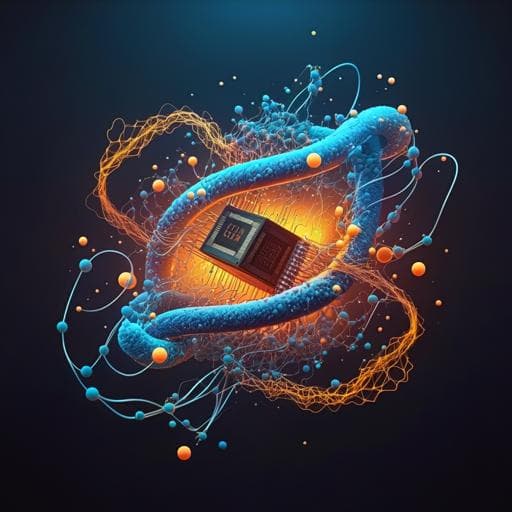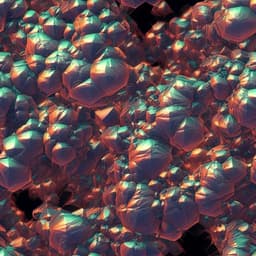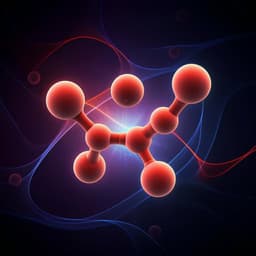
Engineering and Technology
Chemo-mechanical failure mechanisms of the silicon anode in solid-state batteries
H. Huo, M. Jiang, et al.
Explore groundbreaking insights into the chemo-mechanical failure mechanisms of silicon anodes for solid-state batteries! This research, conducted by a team of experts including Hanyu Huo and Ming Jiang, unveils the challenges of capacity decay and mechanical stress that could pave the way for enhanced electrode designs.
~3 min • Beginner • English
Introduction
Solid-state batteries (SSBs) promise higher energy density and improved safety than liquid-electrolyte batteries, but chemo-mechanical effects are more prominent due to rigid solid–solid contacts and disparate mechanical properties among components. Silicon (Si) is an attractive anode for SSBs thanks to its high theoretical capacity (~3,590 mAh g−1 based on Li3.75Si at room temperature), low lithiation potential (~0.3 V vs Li/Li+) and suppressed lithium dendrite formation, along with low cost and air stability. In liquid cells, large Si volume changes lead to particle pulverization and continuous SEI growth, but in SSBs the rigidity of inorganic SEs and external stack pressure may mitigate these issues. Nonetheless, the ~300% volume change upon full lithiation poses substantial chemo-mechanical challenges. The study targets three open questions: (1) SEI formation at the Si|sulfide SE (LPSCI) interface is expected at low potentials, but the SEI components, microstructure and growth rate during cycling need clarification, especially considering surface SiO2 on Si particles. (2) SE-free compact Si anodes create a planar (2D) interface with potentially less SEI per Si mass and reduced irreversible Li loss, but quantitative data on ion/electron transport as a function of state of charge (SoC) are lacking, and the necessity of additives or doping remains unclear. (3) While Si expansion during lithiation can maintain contact, the stability of 2D and 3D Si|SE interfaces during delithiation is uncertain. The purpose is to correlate lithium transport, interfacial chemistry, microstructure evolution, and mechanical misfit across heterointerfaces to elucidate failure mechanisms in composite Si/LPSCI and SE-free Si anodes.
Literature Review
Prior work has highlighted chemo-mechanical challenges in SSBs and the critical role of interfaces. Si is known to alloy at low potentials, avoiding Li dendrites, but undergoes large volume changes that cause pulverization and SEI growth in liquid cells. In sulfide-based SSBs, Si is thermodynamically unstable at low potentials against sulfide SEs, leading to interfacial decomposition and SEI formation. Previous reports explored composite and thin-film Si anodes in SSBs, indicating potential benefits of stack pressure and rigid SEs, and the existence of different degradation pathways than in liquid systems. However, few studies addressed Si particle surface modification, and quantitative assessments of partial ionic/electronic conductivities of lithiated Si across SoC in SE-free architectures were lacking. Additionally, the impact of interface geometry (3D composite versus 2D planar) on SEI growth, transport tortuosity, and mechanical integrity during cycling had not been fully resolved.
Methodology
Materials and electrodes: Coarse-grained LPSCI (NEI) and small-grained LPSCI (Posco JK) were used as solid electrolytes; Si particles (1–5 µm) were from Alfa Aesar. SE-free Si sheet anodes were fabricated by casting a slurry of 99.5 wt% Si and 0.5 wt% PVDF in NMP onto Cu current collectors, dried at 80 °C under vacuum; loading ~1.6 mg cm−2, thickness ~11.5 µm. A PPC modification layer (~1 µm) was prepared by casting a PPC/LiTFSI solution onto Si sheets and drying. Si/LPSCI composite anodes were made by mortaring Si:LPSCI (1:1 wt; Si loading 2.55 mg cm−2) and co-pressing with LPSCI separator at 380 MPa. Cells: Pellet-type cells with LPSCI separator were assembled in Ar glovebox. Half-cells used In/InLi counter/reference and Si anodes (SE-free or composite). A three-electrode configuration (In/InLi reference between two LPSCI layers) enabled separation of working electrode interfacial impedance. Stack pressure during cycling was maintained at 50 MPa; initial pressing at ~380 MPa. Electrochemistry: Time-dependent EIS (1 MHz–0.1 Hz, 10 mV) was used to monitor mixed conductivity of Si/LPSCI composites (SS|Si/LPSCI|SS) and to isolate interfacial resistance Rint (working vs RE) after polarizing to −0.60 V vs In/InLi (~0.02 V vs Li/Li+). A transmission-line or simplified equivalent circuit separated RSE, Rcomp, and Rint. SEI growth kinetics were analyzed via a Wagner-type diffusion-controlled model, extracting rate constants k and k′ (thickness- and resistance-based). GITT on SE-free Si determined lithium chemical diffusion coefficients DLi across SoC by 15 min current pulses at 0.1C with 2 h relaxations; Warburg coefficient and thermodynamic factor were obtained from relaxation analysis. In-situ EIS during GITT relaxations assessed bulk and interfacial resistances (RSi,bulk, Rint) versus SoC; additional time-dependent EIS at OCV after full lithiation yielded k′ for SE-free Si. Full cells paired SE-free Si with NCM@LBO composite cathodes (80:20:3 NCM@LBO:LPSCI:VGCF) using LPSCI (small or coarse). Cycling at 0.05–0.1C within specified voltage ranges; stack pressure evolution tracked (CompreDrive). Structural/chemical characterization: HAADF-STEM, TEM (including cryogenic STEM/EELS), and EDS characterized Si surfaces, Si|LPSCI interfaces, and cycled interphases. XPS monitored interfacial composition evolution (S 2p, Si 2p) before and after 1, 10, 100 cycles. ToF-SIMS (positive/negative ion modes, imaging) identified spatial distribution and intensities of SEI-related fragments (LiP, LiS, LiCl, SiO2) pre- and post-cycling. Cross-sectional SEM/FIB examined microstructure evolution and interface cracking/voiding in composite and SE-free anodes across cycling. Theory and modelling: DFT-based simulations obtained structures of crystalline LixSi (Materials Project) and generated amorphous LixSi via melt-quench. From MD trajectories, ionic conductivities (σion) and activation energies were inferred (temperature-dependent MSD); electronic conductivities (σel) and electron concentrations were evaluated for amorphous LixSi across x. Chemo-mechanically coupled phase-field fracture modelling quantified stress, plastic strain, and void formation at 2D versus 3D interfaces during first lithiation/delithiation.
Key Findings
- Composite Si/LPSCI interfacial instability and SEI growth: In three-electrode cells rested at maximum Li chemical potential after discharge to −0.6 V vs In/InLi, the interfacial resistance Rint increased linearly with √t, consistent with Wagner-type diffusion-controlled growth. The SEI growth rate constant k′ was 10.10 h−1/2 at 25 °C and 50 MPa. DFT indicated Li binds far more strongly to LPSCI than to Si (−7.21 eV vs −0.79 eV), suggesting LPSCI reduction by Li from LixSi. XPS and ToF-SIMS identified SEI components: Li2S, Li3P, LiCl from LPSCI decomposition; SiO2, Li2SiO3, and Li2O from reactions involving the native ~20 nm SiO2 surface layer (SiOx disproportionation during lithiation). ToF-SIMS imaging showed S-rich layers around Si particles after 100 cycles, evidencing a Li2S-rich SEI.
- Transport in SE-free Si: SE-free Si anodes (99.5% Si, 0.5% PVDF) exhibited high specific capacity qm ≈ 3,400 mAh g−1 with decreasing overpotential upon cycling, whereas Si/LPSCI composites delivered ≈2,600 mAh g−1 including ≈120 mAh g−1 SEI capacity. GITT-derived DLi rose from 5.7×10−10 cm2 s−1 at Li0.18Si to 6.9×10−8 cm2 s−1 at Li3.65Si; average DLi ≈ 1.0×10−8 cm2 s−1. DFT for amorphous LixSi yielded average σion ≈ 1.5×10−3 S cm−1 and σel ≈ 4.4×10−4 S cm−1 (e.g., peak σion ≈ 4.1×10−3 S cm−1 at moderate Li content with Ea ≈ 0.225 eV), supporting sufficient mixed conduction without additives.
- Interfacial and bulk resistances (SE-free): RSi,bulk decreased from 64.9 to ~6.7–7.0 Ω cm2 by Li0.75Si and remained low thereafter. Rint decreased from 44.9 to 9.7 Ω cm2 by LiSi, then slightly rose to 12.3 Ω cm2 at full lithiation due to 2D SEI formation. Time-dependent k′ at OCV after full lithiation was 0.30 h−0.5, far below the composite’s 10.10 h−1/2, indicating much slower SEI growth at the 2D interface.
- Cycling stability and failure modes: Under 50 MPa at 0.1C, capacity retention after 100 cycles was poor for both architectures but for different reasons: composites retained ~21.9% due to continuous 3D SEI growth and tortuosity; SE-free Si retained ~29.3% but suffered mechanical contact loss at the 2D interface. SEM revealed in composites: bulk LPSCI cracking after first lithiation and submicrometre interfacial cracks that widened with cycling. In SE-free Si: densification upon lithiation, columnar microstructure after first delithiation, and 2 µm interfacial voids after first delithiation growing to ~10 µm after 100 cycles; EIS reflected increased charge-transfer resistance with contact loss.
- Chemo-mechanics: Phase-field modelling showed high maximum principal stress (~−0.3 to 0.8 GPa reported; ~0.3 GPa highlighted) at the 2D Si|LPSCI interface during lithiation and ~10% plastic strain of the LPSCI separator, rationalizing preferential void formation at 2D interfaces versus 3D composites.
- Full-cell performance and pressure effects: Si|LPSCI|NCM@LBO (small LPSCI) full cells delivered 185.6 mAh g−1 initial discharge and 58.1% retention at 100 cycles (0.1C), outperforming In/InLi|LPSCI|Si half-cells (29.6% retention). Matching half-cells with cut capacity 2,700 mAh g−1 still showed only 35.4% retention, suggesting improved full-cell stability is not solely from partial lithiation. Stack-pressure tracking showed positive pressure changes in full cells (beneficial contact maintenance) versus negative in In/InLi half-cells. A ~1 µm PPC interlayer on Si improved 100-cycle retention to 71.9% and preserved contact (no voids) but reduced initial cathode capacity (~180 to ~160 mAh g−1), indicating transport penalties across PPC-related interfaces.
Discussion
The study disentangles electrochemical and mechanical contributions to failure in Si-based SSB anodes. In composite Si/LPSCI anodes, interfacial decomposition of LPSCI at low potentials and involvement of native SiO2 produce an SEI rich in Li2S, Li3P, LiCl, SiO2, Li2SiO3, and Li2O. This SEI grows with diffusion-controlled kinetics (Rint ∝ √t), causing a pronounced rise in interfacial resistance, increased transport tortuosity, and accelerated capacity fade. Conversely, SE-free Si anodes, lacking electronically insulating LPSCI within the anode and having a simple 2D interface, exhibit higher specific capacity and sufficient mixed ionic/electronic conduction—experimentally (DLi ~10−8 cm2 s−1) and from DFT (σion ~10−3 S cm−1; σel ~10−4 S cm−1)—without the need for conductive additives or doping. However, the planar 2D interface experiences severe chemo-mechanical mismatch during delithiation, leading to void nucleation and growth, which undermines contact and increases interfacial resistance, ultimately compromising cycling stability. Phase-field modelling quantitatively supports that 2D interfaces accumulate higher stresses and plastic strains than 3D composites, explaining the propensity for voids. Full-cell experiments highlight the interplay between electrode volume changes and stack pressure: positive pressure evolution in Si|LPSCI|NCM@LBO cells appears to stabilize interfaces relative to In/InLi half-cells that show negative pressure changes. Introducing a thin PPC buffer layer effectively suppresses interfacial degradation and voiding by mitigating stress and reactivity, albeit with added transport resistance. Overall, the findings address the initial hypotheses: (1) SEI composition and growth at Si|LPSCI are primary drivers of resistance in composites; (2) SE-free Si attains adequate mixed conduction across SoC; (3) interfacial mechanical integrity during delithiation is a critical failure pathway, especially for 2D interfaces.
Conclusion
This work establishes that in Si/LPSCI composite anodes, diffusion-controlled SEI growth (k′ ≈ 10.10 h−1/2) at 3D interfaces—comprising LPSCI reduction products and SiO2-derived species—dominates resistance rise and capacity decay. SE-free Si anodes exhibit intrinsically sufficient ion/electron transport upon lithiation, achieving higher specific capacities (~3,400 mAh g−1) than composites (~2,600 mAh g−1), but suffer chemo-mechanical contact loss at their planar 2D Si|LPSCI interfaces via void formation during delithiation. Phase-field simulations and experiments converge on high interfacial stresses and plasticity as the root cause of 2D interface failure. Full cells with NCM@LBO show better cycle retention (58.1% at 100 cycles) than half-cells, likely aided by favorable stack-pressure evolution; a thin PPC interlayer further improves retention (71.9%) by stabilizing the interface, though at some transport cost. Projected specific energy and energy density for Si-based SSBs are 300 Wh kg−1 and 800 Wh L−1, comparable to Li metal-based SSBs. Future research should focus on: (i) engineering interlayers/coatings with high ionic conductivity and chemical compatibility to suppress SEI growth and mitigate stress; (ii) tailoring electrode microstructures to distribute strains and prevent voiding; (iii) reducing required stack pressures; and (iv) optimizing full-cell architectures, where chemo-mechanical effects differ from half-cells, to enable durable, high-energy Si-based SSBs.
Limitations
Simulated ionic and electronic conductivities for amorphous LixSi are based on idealized bulk models and may deviate from experiments due to impurities, grain boundaries, and defects. SEI growth kinetics are interpreted using a Wagner-type diffusion-controlled framework that assumes ion-dominated transport and geometry-independent kinetics when comparing 2D and 3D interfaces. The experiments rely on high stack pressures (50 MPa cycling; ~380 MPa pressing), which may not directly translate to practical conditions. Half-cell behaviors with In/InLi anodes differ from full cells under confined pressure, complicating extrapolation. The PPC buffer layer introduces added interfacial resistance, reducing initial cathode capacity, indicating a trade-off between stabilization and transport. Not all LixSi phases were synthesized and measured for transport; some conclusions rely on DFT/melt-quench models. Initial overpotentials in SE-free Si and microstructural evolution (e.g., columnar structures) may depend on specific fabrication routes and cycling protocols.
Related Publications
Explore these studies to deepen your understanding of the subject.







